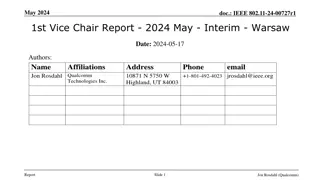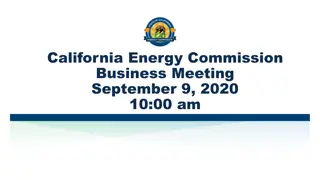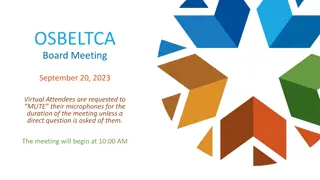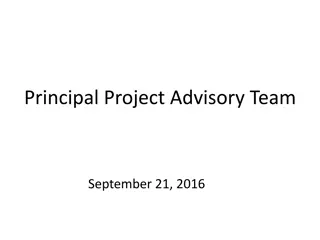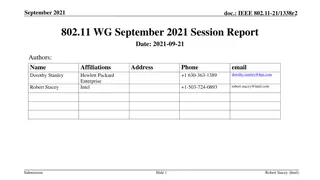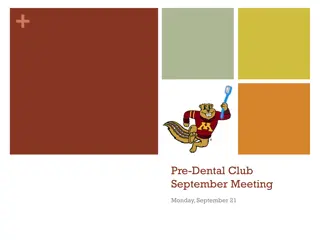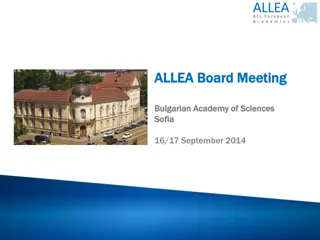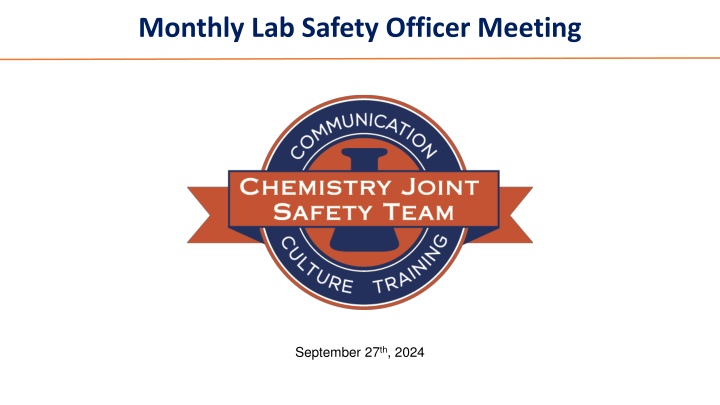
Lab Safety Officer Meeting September 27th, 2024 Agenda and Discussions
Stay updated on the latest safety practices and protocols discussed at the Lab Safety Officer Meeting held on September 27th, 2024. Topics covered include changes in safety forms, reporting incidents, facilities updates, and essential safety practices for chemical refrigerators. Explore important resources and guidelines for maintaining a safe laboratory environment.
Download Presentation

Please find below an Image/Link to download the presentation.
The content on the website is provided AS IS for your information and personal use only. It may not be sold, licensed, or shared on other websites without obtaining consent from the author. If you encounter any issues during the download, it is possible that the publisher has removed the file from their server.
You are allowed to download the files provided on this website for personal or commercial use, subject to the condition that they are used lawfully. All files are the property of their respective owners.
The content on the website is provided AS IS for your information and personal use only. It may not be sold, licensed, or shared on other websites without obtaining consent from the author.
E N D
Presentation Transcript
Monthly Lab Safety Officer Meeting September 27th, 2024
Agenda 1. Announcements a) Change of LSO Form https://forms.gle/BsQQuzsK5F7c3kqq6 b) Reporting Incidents to DRS Phone: 217-333-2755 Email: drs@illinois.edu Submit an Event Report: https://forms.illinois.edu/sec/1674176205?referrer=https://shibboleth.illinois.edu/ c) Anonymous Near Misses and Incidents Form for the JST https://forms.gle/88wVJ8gHXFoMqBtw5 2. Open Discussion Facilities Issues/Updates 3. Recent Near Miss/Incident Reports None submitted this month 4. Safety Minute Chemical Refrigerator Safety Practices 2
Open Discussion/Facilities Updates Any facilities issues or updates Clearing/organizing the storage cabinets in South RAL is in progress. Groups are requested to organize their belongings in those cabinets to allow hassle-free access to the cabinets for F&S. Safety concerns or comments? Suggestions for future meeting topics? 3
Safety Minute: Chemical Refrigerator Safety Practices Laboratory refrigerators are used to store chemicals that are unstable at room temperature and can be volatile, flammable, air-sensitive, noxious and can pose safety hazards if proper maintenance is not carried out. Types of Refrigerators/Freezers: There are primarily three different types of refrigerators/freezers for chemicals: Household: Although not recommended for laboratory use, household refrigerators and freezers may be used for storage of only non-flammable aqueous solutions. Lab-Safe (or Explosion-Safe or Flammable): These are used for storage of flammable or explosive materials. This type of cooling technology has no internal switching devices that can arc or spark as a source of ignition. The compressor and other circuits usually are located at the top of the unit to reduce the potential for ignition of flammable vapors. These refrigerators also incorporate features such as thresholds, self-closing doors, and magnetic door gaskets. Special inner shell materials limit damage should an exothermic reaction occur within the storage compartment. Explosion-Proof: This type is particularly designed to be operational in areas where the air outside the refrigerator might be explosive. This includes liquids, gases, or solids with flashpoints of less than 100 F. In a typical lab setting, explosion-proof refrigerators are usually not necessary. https://drs.illinois.edu/Page/SafetyLibrary/ChemicalStorage https://ehs.oregonstate.edu/sites/ehs.oregonstate.edu/files/pdf/si/labrefrigerators_si.pdf https://ehs.princeton.edu/laboratory-research/laboratory-safety/laboratory-equipment-and-engineering-controls/refrigerators https://ehs.umass.edu/sites/default/files/Flammable%20Storage%20in%20Refrigerators%20%26%20Freezers%20Fact%20Sheet_0.pdf 4
Safety Minute: Chemical Refrigerator Safety Practices Chemical Storage in Refrigerator/Freezer: Flammable chemicals should never be stored in household refrigerators only flammable compatible refrigerators should be used. DRS recommendation is that the refrigerators need to be approved by Underwriters Laboratory (UL) or Factory Mutual (FM) All containers in a refrigerator/freezer should be completely sealed or capped. Containers should not be capped with aluminum foil, corks, and ungreased glass stoppers. All containers should be safely positioned/securely placed so that it does not pose any spilling hazard. Use of a secondary container (e.g., plastic tray) is highly recommended to avoid unstable placement of chemicals on the refrigerator racks. Liquid chemicals should be placed in secondary containers to contain the spill. Incompatible chemicals should be separated using secondary containment. Chemicals and containers should be checked regularly. Compounds stored in refrigerators may be especially prone to degradation if not properly stored and sealed. All chemicals should be properly labeled, especially for synthesized samples. Water-resistant ink should be used for labeling/cover the label with clear tape if water-resistant ink is not available. No food or drink can be stored in a laboratory refrigerator 6
Safety Minute: Chemical Refrigerator Safety Practices Maintenance of Refrigerator/Freezer: Check the refrigerator or freezer regularly to see that the electrical cords are in good condition, the door seals are intact, and the air filter is dust-free and clean. Refrigerator and freezer should be regularly cleaned, checked for ice build-up, and defrosted manually. Ice build-up can pose serious spilling hazards inside the refrigerator. Freezer ice buildup must be corrected immediately to maintain unobstructed access to chemicals, upright storage of bottles, and to ensure that the unit is functioning properly. Power outages and technology failures can cause internal temperatures to rise, which can impact chemical contents. Be aware of unusual odors, vapors, etc., when opening the refrigerator. Refrigerator doors should be properly labeled FLAMMABLES or NON-FLAMMABLES . A NO FOOD/DRINK label is a must requirement by the DRS. Questions/Comments/Concerns? 7
Resources on Lithiation Reaction from DRS https://www.acs.org/content/dam/acsorg/about/governance/committees/chemicalsafety/publications/guides-- tipsheets/lithiantion-reaction-lab-reaction-safety-summary.pdf Recognizing hazards, assessing and minimizing risks, prepare for emergencies 8
Thank you for coming! Please forward LSO meeting recap email/slides to your group! We can stay for a few minutes if there are further questions. We are taking attendance based on the participant list! No need to sign in. 9










